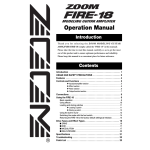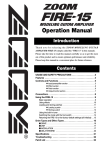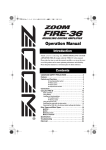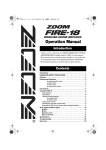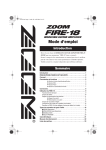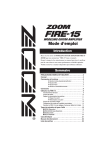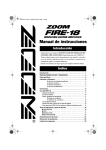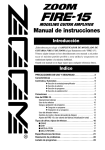Download Zoom modeling amp FIRE-15 Specifications
Transcript
Operation Manual Introduction T h a n k y o u f o r s e l e c t i n g t h e Z O O M M O D E L I N G G U I TA R AMPLIFIER FIRE-30 (simply called the "FIRE-30" in this manual). Please take the time to read this manual carefully so as to get the most out of this product and to ensure optimum performance and reliability. Please keep this manual in a convenient place for future reference. Contents USAGE AND SAFETY PRECAUTIONS . . . . . . . . . . . . . . . . . . . . 2 Features . . . . . . . . . . . . . . . . . . . . . . . . . . . . . . . . . . . . . . . . . . . . 4 Controls and Functions . . . . . . . . . . . . . . . . . . . . . . . . . . . . . . . . 5 ◆ Input/preamplifier section . . . . . . . . . . . . . . . . . . . . . . . . . . . . 5 ◆ Effect section . . . . . . . . . . . . . . . . . . . . . . . . . . . . . . . . . . . . . . 6 ◆ Patch section . . . . . . . . . . . . . . . . . . . . . . . . . . . . . . . . . . . . . . 7 ◆ Output/control section . . . . . . . . . . . . . . . . . . . . . . . . . . . . . . . 8 Connections . . . . . . . . . . . . . . . . . . . . . . . . . . . . . . . . . . . . . . . . . 9 Using the FIRE-30 . . . . . . . . . . . . . . . . . . . . . . . . . . . . . . . . . . . 10 Basic operation . . . . . . . . . . . . . . . . . . . . . . . . . . . . . . . . . . . . . . . . . 10 Using effects . . . . . . . . . . . . . . . . . . . . . . . . . . . . . . . . . . . . . . . . . . . 11 Loading and storing patches . . . . . . . . . . . . . . . . . . . . . . . . . . . . . . . 12 ◆ Loading a patch . . . . . . . . . . . . . . . . . . . . . . . . . . . . . . . . . . . 12 ◆ Storing a patch . . . . . . . . . . . . . . . . . . . . . . . . . . . . . . . . . . . 14 Using the built-in tuner . . . . . . . . . . . . . . . . . . . . . . . . . . . . . . . . . . . . 15 Switching the mode with the foot switch . . . . . . . . . . . . . . . . . . . . . . 16 Returning the FIRE-30 to the factory default settings (all initialize) . . 17 Drive Types and Effect Types . . . . . . . . . . . . . . . . . . . . . . . . . . 18 ■ ■ ■ ■ DRIVE . . . . . . . . . . . . . . . . . . . . . . . . . . . . . . . . . . . . . . . . . . . . . . . 18 ZNR . . . . . . . . . . . . . . . . . . . . . . . . . . . . . . . . . . . . . . . . . . . . . . . . 19 MODULATION . . . . . . . . . . . . . . . . . . . . . . . . . . . . . . . . . . . . . . . . 19 DELAY/REVERB . . . . . . . . . . . . . . . . . . . . . . . . . . . . . . . . . . . . . . 22 Specifications . . . . . . . . . . . . . . . . . . . . . . . . . . . . . . . . . . . . . . 23 Troubleshooting . . . . . . . . . . . . . . . . . . . . . . . . . . . . . . . . . . . . 23 Patch List . . . . . . . . . . . . . . . . . . . . . . . . . . . . . . . . . . . . . . . . . . 24 USAGE AND SAFETY PRECAUTIONS SAFETY PRECAUTIONS In this manual, symbols are used to highlight warnings and cautions for you to read so that accidents can be prevented. The meanings of these symbols are as follows: Warning Caution This symbol indicates explanations about extremely dangerous matters. If users ignore this symbol and handle the device the wrong way, serious injury or death could result. This symbol indicates explanations about dangerous matters. If users ignore this symbol and handle the device the wrong way, bodily injury and damage to the equipment could result. Please observe the following safety tips and precautions to ensure hazard-free use of the FIRE-30. • Power requirements Connect only to AC power outlets rated 100-120 V or 220-240 V 50/60Hz (depending on the Warning voltage range of the unit; refer to the back panel). When not using the unit for an extended time, disconnect the power cord from the AC outlet. • Environment Avoid using your FIRE-30 in environments where it will be exposed to: Caution • Extreme temperatures • High humidity or moisture • Excessive dust or sand • Excessive vibration or shock • Handling Caution The FIRE-30 is a precision instrument. Do not exert undue pressure on the keys and other controls. Also take care not to drop the unit, and do not subject it to shock or excessive pressure. • Alterations Never open the case of the FIRE-30 or attempt to modify the product in any way since this can Warning result in damage to the unit. 2 ZOOM FIRE-30 USAGE AND SAFETY PRECAUTIONS • Volume Caution • Do not use the FIRE-30 at a loud volume for a long time since this can cause hearing impairment. Connecting cables and input and output jacks Caution You should always turn off the power to the FIRE-30 and all other equipment before connecting or disconnecting any cables. Also make sure to disconnect all connection cables and the power cord before moving the FIRE-30. Usage Precautions • Electrical interference For safety considerations, the FIRE-30 has been designed to provide maximum protection against the emission of electromagnetic radiation from inside the device, and protection from external interference. However, equipment that is very susceptible to interference or that emits powerful electromagnetic waves should not be placed near the FIRE-30, as the possibility of interference cannot be ruled out entirely. With any type of digital control device, the FIRE-30 included, electromagnetic interference can cause malfunctioning and can corrupt or destroy data. Care should be taken to minimize the risk of damage. • Cleaning Use a soft, dry cloth to clean the FIRE-30. If necessary, slightly moisten the cloth. Do not use abrasive cleanser, wax, or solvents (such as paint thinner or cleaning alcohol), since these may dull the finish or damage the surface. Please keep this manual in a convenient place for future reference. © ZOOM Corporation Reproduction of this manual, in whole or in part, by any means, is prohibited. ZOOM FIRE-30 3 Features Features • Versatile guitar amplifier and compact effect sound modeling The FIRE-30 lets you select from 22 drive types which faithfully duplicate the sound of famous guitar amplifiers and compact effects. The available choices range from vintage amps to modern distortion sounds, and everything in between. There are also one-touch keys that let you boost the sound, prolong sustain, and emphasize lows or highs. • Digital effects ideal for guitar play The FIRE-30 also incorporates a full range of modulation effects and reverb/delay effects. • Store amp settings as “patches” Multiple amplifier and effect settings can be easily stored as user “patches”. This allows you to instantly call up a desired combination of settings and effects, using the keys on the panel of the unit or using an optional foot switch. A number of preset patches with recommended settings are also available. • POWER DAMP SWITCH With the FIRE-30, you can lower the volume without loss of sound character by power amp. • Built-in auto-chromatic tuner An easy-to-use auto-chromatic tuner is built right into the unit. • Versatile input/output configuration The AUX IN jack makes it easy to connect a CD player, MD player or other source device. The RECORDING/PHONES jack lets you plug in a pair of headphones or a recorder. 4 ZOOM FIRE-30 Controls and Functions Controls and Functions Input/preamplifier section Patch section Output/control section Effect section ◆ Input/preamplifier section This section comprises the input jack and controls for adjusting distortion depth and tone. (2) (1) (4) (3) (5) (6) (7) (9) (8) (10) (1) [INPUT] jack Connect the electric guitar here, using a dedicated instrument cable. (2) [VARIATION] key (3) [DRIVE TYPE] knob Select the simulated amp type and distortion (drive) type. The [DRIVE TYPE] knob gives access to 11 types, and the [VARIATION] key provides further variations (vintage/standard). The LED for the currently selected variation lights up. (4) [GAIN] knob Adjusts the input gain. Turning this knob up increases distortion depth. (5) [BASS]/[MIDDLE]/[TREBLE] knobs This is a 3-band equalizer that allows boost/cut in the low, medium, and high frequency range. ZOOM FIRE-30 5 Controls and Functions (6) [LEVEL] knob Adjusts the volume after passing the preamplifier. (7) [BOOST] key Setting this key to ON (LED lit) boosts the sound pressure level. (8) [SUSTAIN] key Setting this key to ON (LED lit) produces longer sustain. (9) [EDGE] key Setting this key to ON (LED lit) emphasizes the high frequencies. (10) [BOTTOM] key Setting this key to ON (LED lit) emphasizes the low frequencies. ◆ Effect section This section controls the built-in digital effects. The FIRE-30 provides modulation effects and delay/reverb effects. (2) (3) (4) (1) (1) [TYPE] key (MODULATION) Selects the effect type to be used for the modulation effect. The key also turns the modulation effect on or off. (2) [VALUE] knob (MODULATION) Serves to change the effect parameter (effect intensity) of the currently selected modulation effect. (3) [TYPE/TIME] knob (DELAY/REVERB) Selects the effect type to be used as delay/reverb effect and adjusts the effect parameter (reverberation duration and delay interval). (4) [MIX] knob (DELAY/REVERB) Adjusts the depth of the delay/reverb effect (guitar and effect mixing balance). 6 ZOOM FIRE-30 Controls and Functions ◆ Patch section This section lets you store and recall effect patches. It also serves to operate the built-in tuner and noise reduction functions. (4) (5) (7) (6) (8) (1) (2) (3) (1) [MANUAL] key (2) [PROGRAM/BANK] key This key switches between manual mode, where you use the controls on the front panel to shape the sound, and program mode where you use settings stored in preprogrammed patches. When the [MANUAL] key is ON (LED lit), the manual mode is selected. When the [PROGRAM/ BANK] key is ON (LED lit), the program mode is selected. (The default setting at power-on is manual mode.) (3) Display Shows the number of the currently selected patch, or the value of setting parameters of the FIRE-30. (4) [Q]/[W] keys Serve to switch between patches and to adjust ZNR (ZOOM Noise Reduction). (5) [STORE] key Stores the current settings as a user patch. (6) [EXIT] key Cancels an operation and calls up the number of the currently selected patch onto the display. (7) [TUNER] key This key activates the built-in tuner of the FIRE-30. (8) [ZNR] key This key turns ZOOM Noise Reduction on or off. (ZNR is ON by default at power-on.) ZOOM FIRE-30 7 Controls and Functions ◆ Output/control section This section lets you adjust the overall amp volume and connect external devices including a foot switch. (2) (1) (4) (5) (3) (6) (1) [POWER DAMP] switch This switch allows you to lower the volume without loss of sound character by power amp. (2) [MASTER] knob Adjusts the volume. (3) [POWER] switch Controls the power on/off status. (4) FOOT SW jack A separately available foot switch (ZOOM FS-01) can be connected here, allowing you to toggle between manual mode and program mode with your foot. (5) [AUX IN] jack This is a stereo input that accepts the signal from a CD player or MD player. (6) [RECORDING/PHONES] jack This is a stereo output that can be used to connect a recording device or a pair of headphones. 8 ZOOM FIRE-30 Connections Connections This section explains how to operate the panel controls and how to use patches and other Guitar When connecting a multi-effect device (such as the ZOOM 606 or 707II) between the guitar and the FIRE-30, set the [DRIVE TYPE] knob to "EFFECT IN". To input the signal from a CD player or other stereo playback device, use a stereo cable and connect it to the [AUX IN] jack. The signal input here is mixed internally with the guitar signal. CD player or similar 606 or similar effect pedal Power Cord FS01 To toggle between manual mode and program mode with your foot, connect the separately available foot switch ZOOM FS-01 here. To monitor the output of the FIRE-15 with headphones, connect the headphone plug to the [RECORDING/PHONES] jack. (When a plug is inserted in this jack, the speaker output is automatically turned off.) Headphones To record the output of the FIRE-30, connect the recording device such as the ZOOM MRS-1266 to the [RECORDING/PHONES] jack. MRS-1266 or similar recording device ZOOM FIRE-30 9 Using the FIRE-30 Using the FIRE-30 functions of the FIRE-30. Basic operation 1. Verify that the [MASTER] knob is turned to the 0 position. Then turn the [POWER] switch on. Set the [GAIN]/[BASS]/[MIDDLE]/[TREBLE]/[LEVEL] knobs to the center position. Immediately after turning on the power, the manual mode is selected ([MANUAL] key is lit). -2. Display in manual mode Use the [DRIVE TYPE] knob and the [VARIATION] key to select the drive type and variation. Amplifier characteristics and distortion depth will differ, depending on the selected drive type. To create your sound in manual mode, first use the [DRIVE TYPE] knob to select the drive type, and then choose the variation (standard/vintage) with the [VARIATION] key. (For information on available drive types, see page 18.) 3. Raise the [MASTER] knob to a suitable position, and adjust the distortion depth and volume with the [GAIN] knob and [LEVEL] knob while playing your guitar. Normally, you will use the [GAIN] knob to adjust distortion depth and the [LEVEL] knob to adjust the level for a particular patch. The [MASTER] knob controls the overall volume, common to all patches. 4. Use the [BASS]/[MIDDLE]/[TREBLE] knobs to adjust the tone. You can also use the [BOOST], [SUSTAIN], [EDGE], and [BOTTOM] keys to increase the sound pressure, prolong sustain, and emphasize the high or low frequency range. 5. To change the ZNR (ZOOM Noise Reduction) setting, press the [ZNR] key. The LED of the key flashes, and the current setting (Z1 - Z9, oF) is shown for about 2 seconds on the display. Use the [Q]/[W] keys to select the new setting. To switch ZNR on or off, press the [ZNR] key once more. Higher setting values result in more effective noise reduction. Set the value as high as possible without causing the sound to be cut off abruptly. 6. 10 To turn the unit off, turn the [MASTER] knob all the way down and then turn off the [POWER] switch. ZOOM FIRE-30 Using the FIRE-30 Using effects The FIRE-30 incorporates two types of effects (modulation and delay/reverb). This section explains how to activate the effects and use them to achieve various kinds of sound. 1. To use a modulation effect, press the corresponding [TYPE] key. The respective LED lights up and the modulation effect is activated. The selected effect type and setting value are shown for about 2 seconds on the display. Effect type C1 Setting value Available modulation effect types and their abbreviations are listed in the table below. Key (effect type) Code Key (effect type) Code [CHORUS] key C [AUTO WAH] key W [FLANGER] key F [STEP] key S [PHASE] key H [SLOW-A] (slow attack) key A [DOUBLING] key D [PITCH] (pitch shift) key P [TREMOLO] key T [RING MOD] (ring modulator) key R 2. Use the [VALUE] knob. For example, if you press the [CHORUS] key in step 1 and then operate the [VALUE] knob, the setting value changes in the range from C1 to C9, with the effect intensity (in this example the chorus modulation rate) changing accordingly. (For details regarding effect types and setting values, see pages 19 - 22.) H INT • • 3. You can use only one type of modulation effect at a time. Also if the effect type and setting value are not currently shown on the display, the setting value of the currently selected effect type (whose TYPE key LED is lit) will change. To use a delay/reverb effect, turn the [TYPE/TIME] knob and select the effect type and setting value you want to use. ZOOM FIRE-30 11 Using the FIRE-30 When you operate the [TYPE/TIME] knob, the display shows the currently selected effect type and the setting value. Effect type D1 Setting value The available delay/reverb effect types and the corresponding codes are shown in the table below. Key (effect type) Code Key (effect type) Code DELAY D ROOM R ECHO E HALL H When the knob is turned clockwise from the extreme left position, the effect type and value settings cycle as follows: d1 - d9 (delay → E1 - E9 (echo) → r1 - r9 (room) → H1 - H9 (hall). (For details regarding effect types and setting values, see page 22.) 4. Use the [MIX] knob to adjust the ratio of original sound (guitar sound) and delay/reverb sound. The setting range is 0 - 9. Turning the knob clockwise increases the depth of the delay/reverb effect. Turning the knob fully counterclockwise turns the delay/reverb effect off. H INT You can change the effect settings of patches in the same way in program mode. Loading and storing patches The FIRE-30 offers a bank of ten read/write user patches (U) and a bank of ten read-only preset patches (A, b). Patches in each bank are numbered 0 - 9. This section explains how to call up stored user patches or preset patches and how to save amplifier and effect settings in a user patch. ◆ Loading a patch 1. Press the [PROGRAM/BANK] key in the patch section, so that the LED lights up. The FIRE-30 switches from manual mode to program mode, and the currently selected patch is 12 ZOOM FIRE-30 Using the FIRE-30 shown on the display. 0 In program mode, the knobs and controls on the panel become inactive, and the settings of the patch shown on the display are enabled. 2. Use the [Q]/[W] keys to select the bank and number of the desired patch. With the [Q]/[W] keys, you can cycle through the patches in the order U0 - U9 → A0 - A9 → b0 - b9 → U0 ... (For information on factory default patch contents, see page 17.) Patch bank U: User bank; A, b: preset banks 4 Patch number When you press the [PROGRAM/BANK] key, the patch number stays the same and only the bank is toggled: U1 → A1 → b1 → U1. 3. Operate the controls in the input/preamp section and the effect section as required, to adjust the distortion, tone, volume, effect type and intensity, etc. It is also possible to modify a patch after it was loaded. When a knob or key was operated, a dot appears at the bottom right of the display. This indicates that the contents of the patch have changed. (When you return to the original settings, the dot disappears.) 4 Lit H INT You can store the contents of a changed user patch by pressing the [STORE] key. For information on the procedure, see the section "Storing a patch". N OTE If you have changed some settings and then select another patch, the settings of the previous patch will return to the stored condition. If you want to preserve your changes, store the user patch. ZOOM FIRE-30 13 Using the FIRE-30 ◆ Storing a patch N OTE When you store a patch, any patch currently stored under the same number will be overwritten (erased and replaced with the new settings). Take care not to accidentally erase a patch that you want to keep. 1. Use the knobs and keys on the panel to establish the desired sound. 2. Press the [STORE] key in the patch section. The indication "U" (for user bank) and the patch number (0 - 9) are shown on the display. In this condition, storing the settings as a user patch is possible. 0 3. Use the [Q]/[W] keys to select the desired user patch (U0 - U9). The preset patches (A0 - A9, b0 - b9) are read-only and cannot be selected as store targets. 1 4. To store the patch, press the [STORE] key once more. The store process is carried out, and the unit goes into program mode. To cancel the process and return to the condition of step 1, press the [EXIT] key instead of the [STORE] key. H INT By calling up an existing patch and then selecting another destination for the store process, copying a patch is possible. 14 ZOOM FIRE-30 Using the FIRE-30 Using the built-in tuner The FIRE-30 incorporates an auto-chromatic tuner which can be activated by pressing the [TUNER] key. 1. Press the [TUNER] key in the patch section. The LED of the key lights up and the internal tuner becomes active. If you want to tune while keeping the sound output on, press the [TUNER] key only briefly. (The display indication shows "tU".) If you want to tune while the sound is muted, hold down the [TUNER] key somewhat longer. (Release the key when the display indication shows "Mt".) T Mute Hold down 2. MT Play the open string you want to tune The left side of the display shows the note which is closest to the current pitch. The right side of the display shows how far the pitch is off. Adjust the pitch while observing the display. Pitch is sharp Correct pitch Pitch is flat A8 A8 The higher the rotation speed, the more the pitch is off. 3. To change the tuner reference pitch, press one of the [Q]/[W] keys. The current reference pitch is shown for two seconds. The default setting is "40" (center A = 440 Hz). 40 4. While the reference pitch is shown, you can use the [Q]/[W] keys to change the setting. The setting range is 35 - 45 (center A = 435 Hz - 445 Hz). ZOOM FIRE-30 15 Using the FIRE-30 42 N OTE When power is turned off and on again, the reference pitch is reset to "40" (center A = 440 Hz). 5. When tuning is complete, press the [TUNER] key to turn the tuner off. The tuner function is disabled. N OTE During use of the tuner, effects are turned off. Switching the mode with the foot switch Using the separately available foot switch, you can toggle between manual mode and program mode during play. 1. Turn off power to the FIRE-30 and connect the foot switch FS-01 (available separately) to the [FOOT SW] jack. N OTE Please do not connect or disconnect the foot switch while power is turned on. 2. Turn power to the FIRE-30 on. The FIRE-30 is in manual mode. -3. Display in manual mode Press the foot switch while you are playing your instrument. When you push the foot switch, the FIRE-30 switches to program mode, and the currently selected patch becomes active. If required, use the [PROGRAM/BANK] key and [Q]/[W] keys to switch the bank and patch number. A1 16 Program mode display ZOOM FIRE-30 Using the FIRE-30 4. To return to manual mode, press the foot switch again, or press the [MANUAL] key. Returning the FIRE-30 to the factory default settings (all initialize) If required, you can return the settings of the user patches (U0 - U9) to the condition in which the unit was shipped. (This function is called "all initialize".) N OTE When you carry out this function, any settings that you have stored in user patches will be lost. Proceed with care. 1. Hold down the [STORE] key while turning power to the unit on. The indication "AL" appears on the display. AL 2. To execute the all initialize function, press the [STORE] key once more. All user patches are returned to the factory default condition. If you wish to cancel the process, press the [EXIT] key instead of the [STORE] key. ZOOM FIRE-30 17 Drive Types and Effect Types Drive Types and Effect Types ■ DRIVE Selects the modeling material (amp) and distortion type (drive type). Drive type FDR CLEAN MS BG HI GAIN Display FUZZ 18 Name Description VINTAGE FDR BLUES Classic bluesy sound of built-in type tube amp. STANDARD FDR CLEAN Clean sound of built-in type tube amp. VINTAGE J CLEAN Clean bright combo amp sound. STANDARD MATCH Warm and powerful combo amp sound. VINTAGE MS OLD Nostalgic British-style tube stack amp sound. STANDARD MS DRIVE British-style tube stack amp drive sound. VINTAGE BG OLD Sound of an old-style tube combo amp with gutsy midrange. STANDARD BG DRIVE Drive sound of a tube stack amp with gutsy midrange. VINTAGE MP 1 Sound of a high-gain tube preamplifier. STANDARD PVY Tube stack amp drive sound in the heavy metal style. VINTAGE 9002 ZOOM original 9002 sound. STANDARD Z POWER ZOOM original powerful amp sound. VINTAGE VINTAGE OD Sound of dry overdrive effect connected to combo amp. STANDARD TB DIST Sound of fully revved up distortion effect connected to combo amp. VINTAGE WILD FUZZ Sound of high-gain aggressive fuzz connected to stack amp. STANDARD FUZZ Sound of nostalgic sixties fuzz connected to stack amp. FD CL MS BG HG M ZOOM OD/DIST Variation OD F ZOOM FIRE-30 Drive Types and Effect Types METAL ACOUSTIC EFFECT IN VINTAGE MTZ Typical metal style sound with distinctive midrange. STANDARD MT 7 Heavy metal sound great for 7-string guitar. VINTAGE AC FAT STANDARD AC STANDARD Changes the sound of an electric guitar into that of an acoustic guitar. The DRIVE [VARIATION] key switches the style between fat and standard. VINTAGE VINTAGE STANDARD STANDARD MT A E Clean guitar amp sound great for direct input to a ZOOM multi-effect processor. The VINTAGE setting produces an even tighter sound. ■ ZNR This is ZOOM's original noise reduction which suppresses noise during play pauses. Use the [ZNR] key to turn the function on and off, and use the [Q]/[W] keys to adjust the setting value. Setting value 1 ZNR 9 Description Higher settings result in more effective noise reduction. Set the value as high as possible without causing the sound to be cut off abruptly. ■ MODULATION This effect gives body and vibration to the guitar sound. Use the [TYPE] key to select the effect type and use the [VALUE] knob to adjust the setting value. Effect type CHORUS Setting value C1 C9 F1 FLANGER ZOOM FIRE-30 F6 Description Mixes pitch-shifted components (up and down) to original signal, for spacious and solid sound. Higher setting values result in deeper chorus effect. Pitch-up/down modulation adds pronounced character to the sound. Higher setting values result in faster modulation. 19 Drive Types and Effect Types FLANGER →CHORUS F7 F9 H1 PHASE PHASE→ CHORUS H6 H7 H9 D1 DOUBLING DOUBLING →CHORUS D6 D7 D9 T1 TREMOLO TREMOLO →CHORUS T6 T7 T9 W1 AUTO WAH AUTO WAH →CHORUS W6 W7 W9 S1 STEP 20 S6 Serial connection of flanger and chorus. Higher setting values result in faster flanger modulation. (Chorus depth is fixed.) Adds a swooshing modulation to the sound. Higher setting values result in faster flanger modulation. Serial connection of phaser and chorus. Higher setting values result in faster phaser modulation. (Chorus depth is fixed.) This effect adds a very short-delay sound to the original sound, which gives the impression of several players playing the same phrase, resulting in more solid sound. Higher setting values result in stronger doubling action. Serial connection of doubling and chorus. Higher setting values result in stronger doubling action. (Chorus depth is fixed.) This effect varies the volume periodically. Higher setting values result in faster tremolo. Serial connection of tremolo and chorus. Higher setting values result in faster tremolo. (Chorus depth is fixed.) This is an effect that automatically adds wah depending on the playing intensity. Higher setting values result in higher auto wah start sensitivity, producing wah even with low-level signals. Serial connection of auto wah and chorus. Higher setting values result in higher auto wah start sensitivity. (Chorus depth is fixed.) This effect causes random pitch changes and creates an auto arpeggio sound. Higher setting values result in faster sound change. ZOOM FIRE-30 Drive Types and Effect Types S7 STEP→CHORUS S9 A1 SLOW-A A6 A7 SLOW-A→PITCH A9 Serial connection of step and chorus. Higher setting values result in faster sound change. (Chorus depth is fixed.) This effect slows down the sound attack speed, resulting in the impression of “violin playing”. Higher setting values result in slower attack speed. Serial connection of slow attack and pitch shift. Higher setting values result in slower attack speed. (Pitch shift is fixed to one octave higher.) This effect varies the pitch of the original sound. You can select one of nine preset pitch shift patterns (P1 - P9). P1 Mixes the original sound and a sound component shifted one octave down. P2 Mixes the original sound and a sound component shifted a perfect fifth down. P3 Adds a chorus effect to the P2 setting. P4 Mixes the original sound and a sound component shifted a perfect fourth down. P5 Adds a chorus effect to the P4 setting. P6 Mixes the original sound and a sound component shifted one octave up. P7 Mixes the original sound and a sound component shifted slightly, resulting in a chorus effect with only slight modulation. P8 Mixes the original sound and sound components shifted a perfect fourth down and up. P9 Mixes the original sound and sound components shifted an octave down and up. R1 Adds amplitude modulation to the sound, resulting in a metallic effect. Higher setting values result in higher modulation frequency. PITCH RING MOD ZOOM FIRE-30 R6 21 Drive Types and Effect Types RING MOD →CHORUS R7 R9 Serial connection of ring modulator and chorus. Higher setting values result in higher modulation frequency. (Chorus depth is fixed.) ■ DELAY/REVERB This effect adds a delayed component or reverb to the guitar sound. Use the [TYPE/TIME] knob to select the effect type and setting value, and use the [MIX] knob to adjust the ratio of effect sound and original sound. Effect type Setting value D1 DELAY D9 E1 ECHO E9 R1 ROOM R9 H1 HALL 22 H9 Description This is a conventional digital delay effect. Higher setting values result in longer delay time. The feedback amount is set to an optimum value. This delay effect recreates the warm sound of a tape echo. Higher setting values result in longer delay time. The feedback amount is set to an optimum value. This effect simulates reverberation in a room. Higher values result in a deeper effect. This effect simulates reverberation in a hall. Higher values result in a deeper effect. ZOOM FIRE-30 Specifications Power Output Speaker Inputs Output Drive Effect Programs Effect Modules Program Patches Sampling Frequency A/D Conversion D/A Conversion Control Connector Display Dimension Weight Included Items Troubleshooting 36 W RMS 25 cm, 5 ohms Guitar input : standard mono phone jack (nominal input level -20 dBm,input impedance 470 kilohms) AUX IN : standard stereo phone jack(nominal input level -20 dBm,input impedance 10 kilohms) Combined recording/headphone output: standard stereo phone jack (nominal output level +4 dBm with output load impedance 10 kilohms or higher) 22 types 19 types (10 MODULATION + 4 DELAY/REVERB + BOOST + SUSTAIN + EDGE + BOTTOM + ZNR) 7 modules (MODULATION + DELAY/REVERB + BOOST + SUSTAIN + EDGE + BOTTOM + ZNR) USER : 10 (rewritable, with store) PRESET : 2 banks x 10 = 20 Total 30 patches 31.25 kHz 20-bit, 64-times oversampling 20-bit, 8-times oversampling FOOT SW (FS01) 2-position 7-segment LED 485 mm (W) x 240 mm (D) x 410 mm (H) 12 kg Power Cord *0 dBm = 0.775 Vrms *Design and specifications subject to change without notice. Troubleshooting • Power does not come on. • Is power cord correctly plugged into AC outlet? • Is [POWER] switch set to ON? • No sound, or low volume. • Is the guitar correctly connected to the FIRE-30? See page 9 for information on connections. • Is something plugged into the [RECORDING/PHONES] jack? If something is plugged into the [RECORDING/PHONES] jack, the speaker is automatically cut off. • Is the [LEVEL] knob or [MASTER] knob turned down? Turn the knobs clockwise while playing your guitar. • Sound is too distorted or breaks up. • [GAIN]/[LEVEL] knobs may be turned up too high? Turn the knobs counter-clockwise. Adjust the volume with the [MASTER] knob. • The foot switch does not toggle modes. • Is a ZOOM foot switch connected? Use only the foot switch ZOOM FS-01. ZOOM FIRE-30 23 Patch List BANK U A b PATCH PATCH NAME 0 Fire Drive 1 Pop Chorus 2 Delayed OD 3 Metal 7 4 Beat Crunch 5 Phaser Cut 6 Z-Box 7 Pitched DRV 8 Strum Arp 9 Jet Drive 0 PV-Hard 1 Clear Chorus 2 Z-Power 3 M-Stack 4 Combo Drive 5 FDR-Clean 6 X-Distortion 7 BG-Stack 8 MP-Power 9 Match Box 0 Wild Fuzz 1 Clean Lead 2 Fat Tweed 3 Outline Dist 4 Mystic Chord 5 Old Stack 6 Silver Panel 7 Wah Useful 8 UK Box 9 Neo Fuzz DRIVE TYPE COMMENT Powerful drive sound with huge and full sonic impact. J CLEAN Deformed combo amp sound with characteristic chorus. VINTAGE OD Overdrive sound with delay suitable for melody and lead. MT 7 Metal sound for 7-string guitar. MS OLD Standard crunch sound for useful from rhythm to lead. EFFECT IN (St) Phaser sound for cutting. 9002 Deformation of the vintage original ZOOM sound. BG OLD Standard pitch sound added downer 1-octave. AC STANDARD Acoustic sound for stroke and arpeggio. MP 1 Crispy, useful jet sound. PVY Simulation of the drive feeling of the high gain amp sound. EFFECT IN (St) Clear, transparent clean chorus sound. Z POWER Power lead sound of the ZOOM original. MS DRIVE Simulation of the standard stack amp sound. BG OLD Light drive combo amp sound. FDR CLEAN Standard amp sound for studio recording. TB DIST Simulation of stomp box distortion. BG DRIVE Simulation of the BG stack amp sound. MP 1 Amp sound that has hard distortion and quick response. MATCH High quality crunch sound simulating the combo amp. WILD FUZZ Powerful fuzz sound use for backing and lead EFFECT IN (Vin) Chorus & Delay sound for clean lead. FDR BLUES Fat sound attached weight to the mid range. TB DIST Sound of the accentuating outline with short delay. J CLEAN Fantastic pitch sound use for chord arpeggio. MS OLD Simulation of the typical old stack amp sound. Simulation of the combo amp sound that has characteristic FDR CLEAN tremolo and reverb. PVY Almighty auto-wah sound. MATCH Mersey beat type combo amp sound FUZZ Fuzzy sound that studio musician uses habitually. PVY ZOOM CORPORATION NOAH Bldg., 2-10-2, Miyanishi-cho, Fuchu-shi, Tokyo 183-0022, Japan PHONE: +81-42-369-7116 FAX: +81-42-369-7115 Web Site: http://www.zoom.co.jp FIRE-30- 5000-1
























